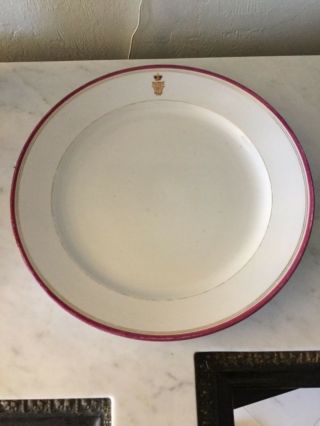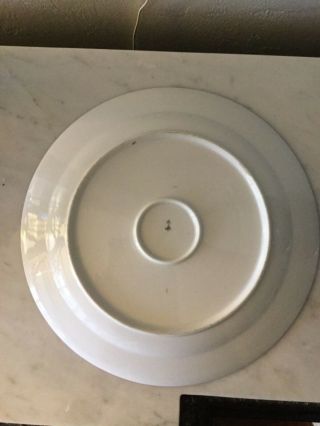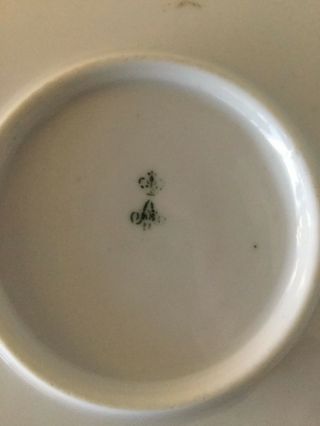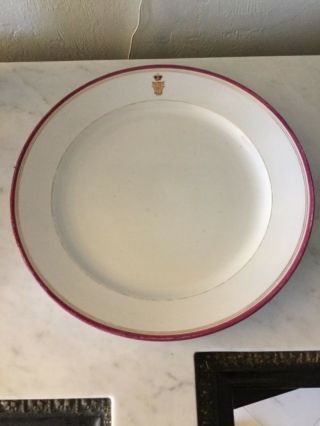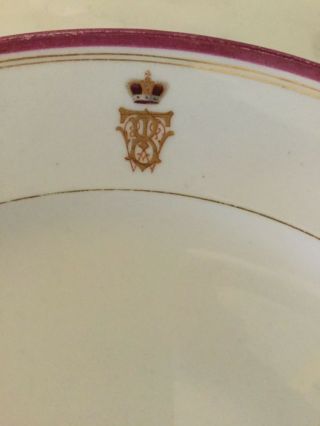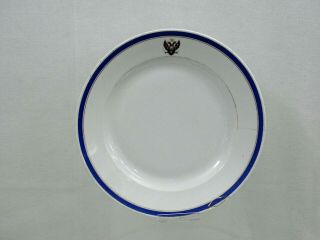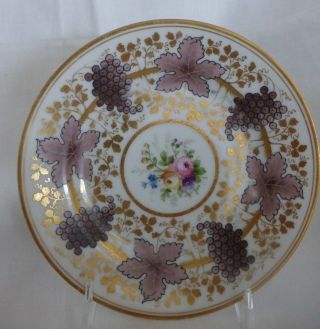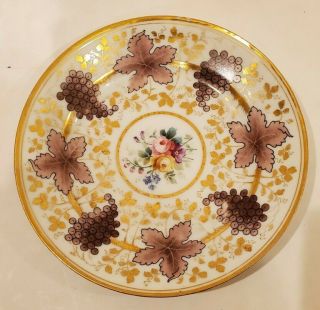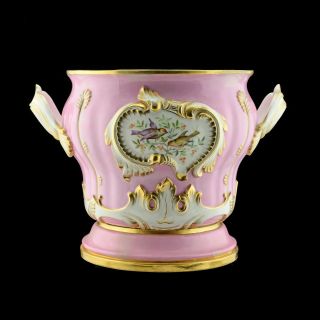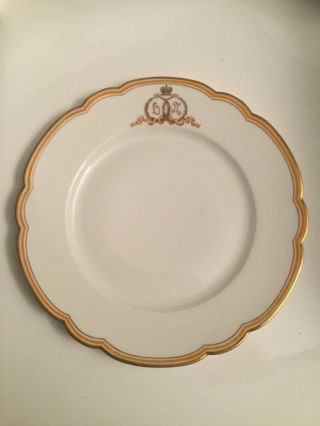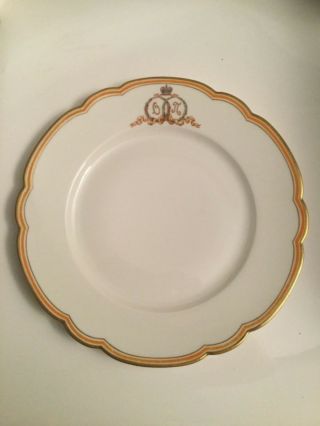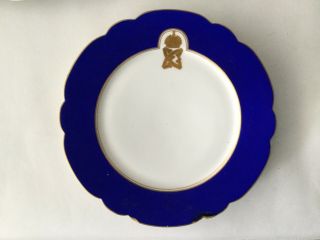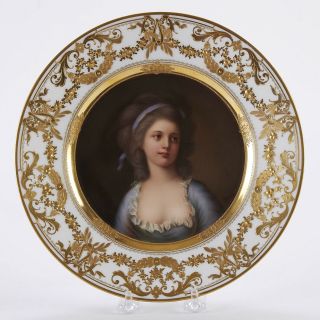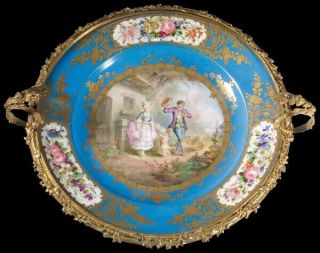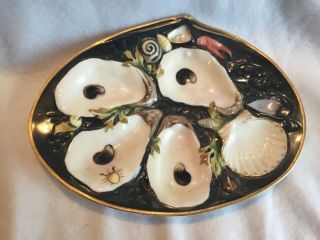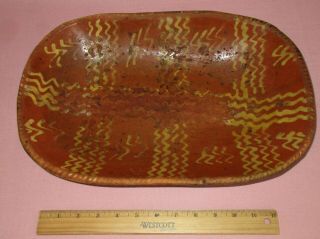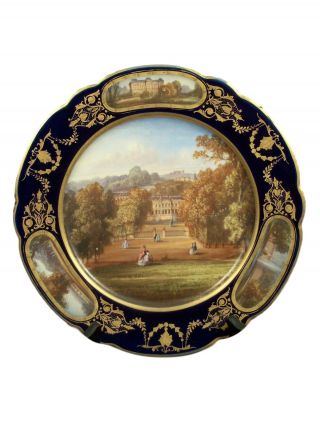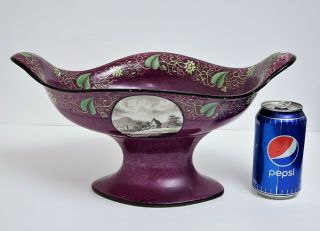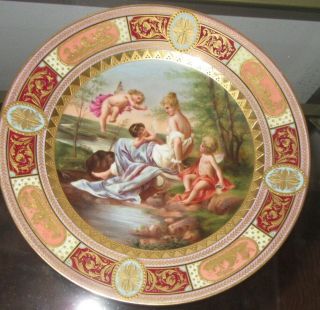RUSSIAN IMPERIAL PORCELAIN FACTORY, Plate Prince Barclay De Tolly ‘s Service
Item History & Price
Michael Andreas Barclay de Tolly[nb 1] (27 December [O.S. 16 December] 1761 – 26 May [O.S. 14 May] 1818) was a Russian Field Marshal and Minister of War during Napoleon's invasion in 1812 and War of the Sixth Coalition. Barclay implemented a number of reforms during this time that improved supply system in the army, doubled the number of army troops, and implemented new combat training principles. He was also the Governor-General of Finland.General Prince
Michael Andreas Barclay de TollyPortrait of Barclay de Tolly from the Military Gallery of the Winter Palace, by George DaweBorn27 December 1761
Pamūšis, Courland and SemigalliaDied24 September [O.S.12 September] 1818
Insterburg (Chernyakhovsk), PrussiaBuriedJõgeveste, EstoniaAllegiance Russian EmpireService/branchImperial Russian ArmyYears of service1776–1818RankField MarshalCommands heldGovernor-General of Finland
Minister of WarBattles/warsRusso-Turkish War (1787–92)Siege of OchakovRusso-Swedish War (1788–90)
Kościuszko UprisingBattle of PragaFinnish War
Napoleonic WarsBattle of PułtuskBattle of EylauBattle of SmolenskBattle of BorodinoBattle of BautzenBattle of DresdenBattle of KulmBattle of LeipzigBattle of La RothièreBattle of Arcis-sur-AubeBattle of Fère-ChampenoiseBattle of ParisAwardsOrder of St. GeorgeHe was born into a German-speaking noble family from Livonia who were members of the Scottish Clan Barclay. His father was the first of his family to be accepted into the Russian nobility. Barclay joined the Imperial Russian Army at a young age in 1776, enlisting in the Pskov Carabineer Regiment. For his role in the capture of Ochakov in 1788 from the Ottomans, he was personally decorated by Grigory Potemkin. Afterwards he participated in Catherine II's Swedish War. In 1794, he took part in putting down the Kościuszko Uprising in Poland and was again decorated for role in the capture of Vilnius.In 1806, Barclay began commanding in the Napoleonic Wars, distinguishing himself at the Battle of Pułtusk that same year. He was wounded at the Battle of Eylau in 1807 while his troops were covering the retreat of the Russian army. Because of his wounds, he was forced to leave command. The following year, he carried out successful operations in the Finnish War against Sweden. Barclay led a large number of Russian troops approximately 100km across the frozen Gulf of Bothnia in winter during a snowstorm. For his accomplishments, Barclay de Tolly was appointed Governor-General of the Grand Duchy of Finland. From 20 January 1810 to September 1812 he was the Minister of War of the Russian Empire.When the French invasion of Russia began in 1812, Barclay de Tolly was commander of the 1st Army of the West, the largest Army to face Napoleon. Barclay was appointed Commander-in-Chief and initiated a scorched earth policy from the beginning of the campaign, though this made him unpopular among Russians. After the Battle of Smolensk failed to halt the French and discontent among Russians continued to grow, Alexander I appointed Mikhail Kutuzov as Commander-in-Chief, though Barclay remained in charge of the 1st Army. However, Kutuzov continued the same scorched earth retreat up to Moscow where the Battle of Borodino took place nearby. Barclay commanded the right wing and center of the Russian army for the battle. After Napoleon's retreat, the eventual success of Barclay's tactics made him a hero among Russians. He became Commander-in-Chief once again in 1813 after the death of Kutuzov and led the taking of Paris, for which he was made a Field Marshal. His health later declined and he died on a visit to Germany in 1818.ContentsEarly life and familyEditBarclay de Tolly, a member of the Scottish Clan Barclay with roots in Towie (Towy or Tolly, Scottish Gaelic: Tollaigh) in Aberdeenshire, [1] was born in Pamūšis, [2][3] Courland and Semigallia (in present-day Pakruojis District Municipality, Šiauliai County, Lithuania) and raised in Jõgeveste, Livonia, Russian Empire (now part of Estonia). The commonly accepted birth date of 27 December 1761 is actually the day of his baptism in the Lutheran church of the town Žeimelis.[4] He was a German-speaking descendant of a Scottish family: his ancestor Peter Barclay had settled in Livonia in the 17th century. From 1765 the young Barclay de Tolly grew up in Saint Petersburg and was raised by his aunt. Gregory Fremont-Barnes and Todd Fisher, who are amongst the world's leading Napoleonic-era scholars, [citation needed] state that this was a common occurrence amongst the German Protestants, and gave the young man an exposure to higher society unavailable in the Baltic provinces.[5] De Tolly's grandfather Wilhelm served as the mayor of Riga, while his father Bogdan Barclay de Tolly (1734-1781) had served in the Russian army before being admitted into the ranks of Russian nobility by the Tsar.[5] Mikhail Barclay de Tolly himself, the future field marshal, started active service in the Imperial Russian Army in 1776, and would spend the rest of his life with the military.[5][dead link]Service historyEditYoung Barclay was enlisted in the Pskov Carabineer Regiment on 13 May 1767, and achieved the rank of a cornet by May 1778.[citation needed] In the same year, he joined the Imperial jaeger regiments, and joined alongside the rest of his unit the army of Prince Potemkin.[5] In 1788–1789, during the Russo-Turkish War of 1787-1792, Barclay served against the Turks, under the command of Victor Amadeus of Anhalt-Bernburg-Schaumburg-Hoym. During this campaign, he distinguished himself in the taking of Ochakov and Akkerman. In 1789, he was transferred to the Finnish front during the Russo-Swedish War of 1788-1790, [5] and four years later, he fought against the Poles.[5]He was a lieutenant colonel by 1794 after serving as aide-de-camp to various senior officers in several campaigns. In that year he was appointed commander of the Estland Jaeger Corps, and three years later commander of the 4th Jaeger Regiment, becoming its chief in 1799, soon after being promoted to general major for his service in the Polish Campaign of 1794.[6]Coat of arms of princes Barclay de TollyIn the war of 1806 against Napoleon, Barclay took a distinguished part in the Battle of Pultusk (December 1806) and was wounded at the Battle of Eylau (7 February 1807), where his conduct won him promotion to the rank of lieutenant general.[7] After a period of convalescence, Barclay returned to the army and in 1808 commanded operations against the Swedes during the Finnish War. In 1809, he successfully marched over the frozen Gulf of Bothnia, which allowed him to surprise the enemy and seize Umeå in Sweden.[7] For this exploit, immortalized by the Russian poet Baratynsky, he was made full general and Governor-General of Finland. A year later, he became Minister of War, retaining the post until 1813.[7]Statue of Barclay de Tolly in front of the Kazan Cathedral in St Petersburg, by Boris OrlovskyNapoleon's invasionEditDuring Napoleon's invasion of Russia in 1812, Barclay assumed the supreme command of the 1st Army of the West, the largest of the Russian armies facing Napoleon. He used a strategy of retreat leaving behind scorched earth from the beginning of the campaign in order to draw the French supply lines deep into Russian territory and retreated to the village of Tsaryovo-Zaimishche between Moscow and Smolensk, although some consider the strategy merely an confluence of diverse circumstances and not attributable to the will of one man.[8]Nevertheless, the Russians keenly opposed the appointment of a foreigner as commander-in-chief. His rivals spread rumors of his being Napoleon's agent, and the populace condemned him as a coward. Barclay was forced by his subordinates and the Tsar to engage Napoleon at Smolensk (17–18 August 1812). Napoleon forced Barclay to retreat when he threatened Barclay's only escape route. After losing the Holy City of Smolensk, the outcry of officers and civilians grew to a point where the Tsar could no longer ignore it. He appointed Kutuzov, previously a general at the battle of Austerlitz, as the over-all commander of the Russian forces. Barclay remained General of the 1st Army of the West.Barclay commanded the right flank at the Battle of Borodino (7 September 1812) with great valour and presence of mind and during the celebrated council at Fili advised Kutuzov to surrender unfortified Moscow to the enemy. His illness made itself known at that time and he was forced to leave the army soon afterwards.After Napoleon was driven from Russia, the eventual success of Barclay's tactics made him a romantic hero, misunderstood by his contemporaries and rejected by the court. His popularity soared, and his honour was restored by the tsar.Foreign campaignsEditBarclay was re-employed in the field and took part in the German Campaign of 1813 and the French Campaign of 1814, which ended the War of the Sixth Coalition (1812–1814). After Kutuzov's death, he once again became commander-in-chief of the Russian forces at the Battle of Bautzen (21 May 1813), and in this capacity he served at Dresden (26–27 August 1813), Kulm (29–30 August 1813) and Leipzig(16–19 October 1813). In the latter battle he commanded a central part of the Allied forces so effectively that the tsar bestowed upon him the title of count.Barclay de Tolly Mausoleum in Jõgeveste, southern EstoniaBarclay took part in the invasion of France in 1814 and commanded the taking of Paris, receiving the baton of a Field Marshal in reward. In 1815 he again served as commander-in-chief of the Russian army which after the Hundred Days occupied France, and was created prince at the close of the war.As his health grew worse, he left the military and settled down in his Jõgeveste manor (German exonym: Beckhof, Polish: Tepelshof) (nowadays Southern Estonia).[9] Barclay de Tolly died at Insterburg (Chernyakhovsk), East Prussia, on 26 May 1818 (14 May, Old Style) on his way from his Livonian manor to Germany, where he wanted to renew his health. His and his wife Helene Auguste Eleonore von Smitten's remains were embalmed and put into the mausoleum built to a design by Apollon Shchedrin and Vasily Demut-Malinovsky in 1832 in Jõgeveste (in Helme, Estonia).Bust of Barclay de Tolly in Tartu, Estonia.A grand statue of him was erected in front of the Kazan Cathedral in St Petersburg on behest of Emperor Nicholas I. There are also a modern statue in Riga, a full size bronze mounted statue by Vladimir Surovtsev in Chernyakhovsk, a bust monument in Tartu, and the so-called "Barclay's leaning house" in Tartu (which was acquired by his widow after his death).After the extinction of the Barclay de Tolly princely line with his son Magnus on 29 October 1871 (17 October, Old Style), Alexander II allowed the field marshal's sister's grandson through female lineage, Alexander von Weymarn, to assume the title of Prince Barclay de Tolly-Weymarn on 12 June 1872 (31 May, Old Style)[10]Awards and decorationsEditOrder of St. Andrew (7 September 1813)Order of St. George - Barclay de Tolly was the second of four full Knights of St. George in the history of the Order. This includes his contemporary, Kutuzov;1st class (19 August 1813, № 11) - "For the defeat of the French at the Battle of Kulm 18 August 1813";2nd class bol.kr. (21 October 1812, № 44) - "For his part in the Battle of Borodino on 26 August 1812";3rd class (8 January 1807, № 139) - "In the great reward of bravery and courage, rendered in the battle against the French troops on December 14th at Pultusk, where he commanded the vanguard ahead pravago flank, with a special skill and prudence kept the enemy at all times of battle and overturned Nadezhda";4th class (16 September 1794, № 547) - "For outstanding courage, rendered against the Polish insurgents in the capture of fortifications and by the mountains. Villeneuve";Gold Sword for Bravery with diamonds and laurels with the inscription" for 20 January 1814" (1814);Order of St. Vladimir, 1st class (15 September 1811), 2nd class (7 March 1807), 4th class (12 July 1788);Order of St. Alexander Nevsky (9 September 1809); diamonds added (9 May 1813);Order of St. Anna, 1st class (7 March 1807);Golden Cross for taking Ochakov (7 December 1788);Cross "For the victory of Eylau" (1807);Order of the Red Eagle (Prussia, 1807);Order of the Black Eagle (Prussia, 1813);Commander of the Military Order of Maria Theresa (Austria, 1813);Order of the Sword, 1st class (Sweden, 1814);Grand Cross of the Legion of Honour, (France, 1815);Honorary Knight Grand Cross of the Order of the Bath, (UK, 1815);Sword with diamonds (UK, 1816);Military William Order, 1st class (Netherlands, 1815);




